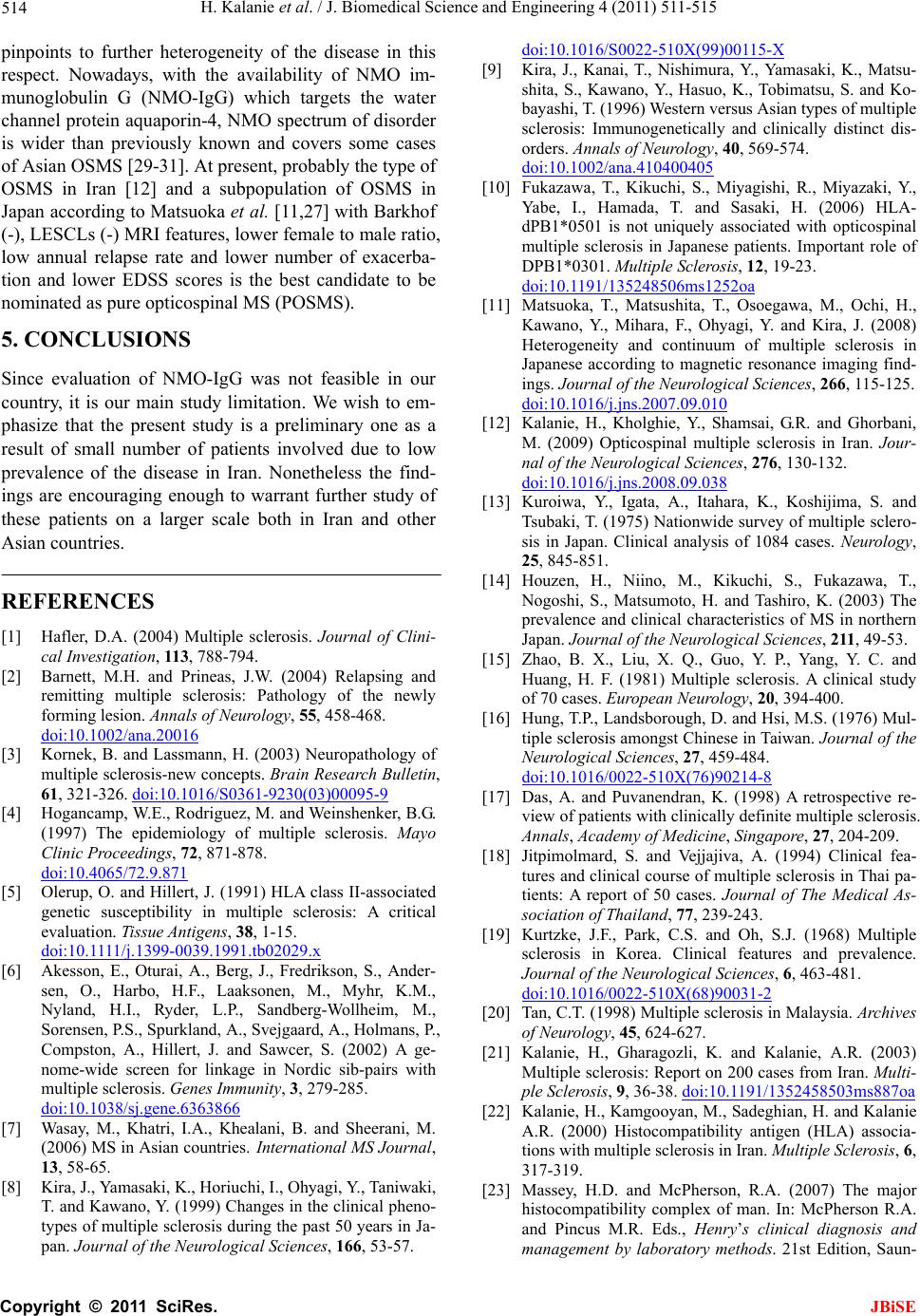
H. Kalanie et al. / J. Biomedical Science and Engineering 4 (2011) 511-515
514
pinpoints to further heterogeneity of the disease in this
respect. Nowadays, with the availability of NMO im-
munoglobulin G (NMO-IgG) which targets the water
channel protein aquaporin-4, NMO spectrum of disorder
is wider than previously known and covers some cases
of Asian OSMS [29-31]. At present, probably the type of
OSMS in Iran [12] and a subpopulation of OSMS in
Japan according to Matsuoka et al. [11,27] with Barkhof
(-), LESCLs (-) MRI features, lower female to male ratio,
low annual relapse rate and lower number of exacerba-
tion and lower EDSS scores is the best candidate to be
nominated as pure opticospinal MS (POSMS).
5. CONCLUSIONS
Since evaluation of NMO-IgG was not feasible in our
country, it is our main study limitation. We wish to em-
phasize that the present study is a preliminary one as a
result of small number of patients involved due to low
prevalence of the disease in Iran. Nonetheless the find-
ings are encouraging enough to warrant further study of
these patients on a larger scale both in Iran and other
Asian countries.
REFERENCES
[1] Hafler, D.A. (2004) Multiple sclerosis. Journal of Clini-
cal Investigation, 113, 788-794.
[2] Barnett, M.H. and Prineas, J.W. (2004) Relapsing and
remitting multiple sclerosis: Pathology of the newly
forming lesion. Annals of Neurology, 55, 458-468.
doi:10.1002/ana.20016
[3] Kornek, B. and Lassmann, H. (2003) Neuropathology of
multiple sclerosis-new concepts. Brain Research Bulletin,
61, 321-326. doi:10.1016/S0361-9230(03)00095-9
[4] Hogancamp, W.E., Rodriguez, M. and Weinshenker, B.G.
(1997) The epidemiology of multiple sclerosis. Mayo
Clinic Proceedings, 72, 871-878.
doi:10.4065/72.9.871
[5] Olerup, O. and Hillert, J. (1991) HLA class II-associated
genetic susceptibility in multiple sclerosis: A critical
evaluation. Tissue Antigens, 38, 1-15.
doi:10.1111/j.1399-0039.1991.tb02029.x
[6] Akesson, E., Oturai, A., Berg, J., Fredrikson, S., Ander-
sen, O., Harbo, H.F., Laaksonen, M., Myhr, K.M.,
Nyland, H.I., Ryder, L.P., Sandberg-Wollheim, M.,
Sorensen, P.S., Spurkland, A., Svejgaard, A., Holmans, P.,
Compston, A., Hillert, J. and Sawcer, S. (2002) A ge-
nome-wide screen for linkage in Nordic sib-pairs with
multiple sclerosis. Genes Immunity, 3, 279-285.
doi:10.1038/sj.gene.6363866
[7] Wasay, M., Khatri, I.A., Khealani, B. and Sheerani, M.
(2006) MS in Asian countries. International MS Journal,
13, 58-65.
[8] Kira, J., Yamasaki, K., Horiuchi, I., Ohyagi, Y., Taniwaki,
T. and Kawano, Y. (1999) Changes in the clinical pheno-
types of multiple sclerosis during the past 50 years in Ja-
pan. Journal of the Neurological Sciences, 166, 53-57.
doi:10.1016/S0022-510X(99)00115-X
[9] Kira, J., Kanai, T., Nishimura, Y., Yamasaki, K., Matsu-
shita, S., Kawano, Y., Hasuo, K., Tobimatsu, S. and Ko-
bayashi, T. (1996) Western versus Asian types of multiple
sclerosis: Immunogenetically and clinically distinct dis-
orders. Annals of Neurology, 40, 569-574.
doi:10.1002/ana.410400405
[10] Fukazawa, T., Kikuchi, S., Miyagishi, R., Miyazaki, Y.,
Yabe, I., Hamada, T. and Sasaki, H. (2006) HLA-
dPB1*0501 is not uniquely associated with opticospinal
multiple sclerosis in Japanese patients. Important role of
DPB1*0301. Multiple Sclerosis, 12, 19-23.
doi:10.1191/135248506ms1252oa
[11] Matsuoka, T., Matsushita, T., Osoegawa, M., Ochi, H.,
Kawano, Y., Mihara, F., Ohyagi, Y. and Kira, J. (2008)
Heterogeneity and continuum of multiple sclerosis in
Japanese according to magnetic resonance imaging find-
ings. Journal of the Neurological Sciences, 266, 115-125.
doi:10.1016/j.jns.2007.09.010
[12] Kalanie, H., Kholghie, Y., Shamsai, G.R. and Ghorbani,
M. (2009) Opticospinal multiple sclerosis in Iran. Jour-
nal of the Neurological Sciences, 276, 130-132.
doi:10.1016/j.jns.2008.09.038
[13] Kuroiwa, Y., Igata, A., Itahara, K., Koshijima, S. and
Tsubaki, T. (1975) Nationwide survey of multiple sclero-
sis in Japan. Clinical analysis of 1084 cases. Neurology,
25, 845-851.
[14] Houzen, H., Niino, M., Kikuchi, S., Fukazawa, T.,
Nogoshi, S., Matsumoto, H. and Tashiro, K. (2003) The
prevalence and clinical characteristics of MS in northern
Japan. Journal of the Neurological Sciences, 211, 49-53.
[15] Zhao, B. X., Liu, X. Q., Guo, Y. P., Yang, Y. C. and
Huang, H. F. (1981) Multiple sclerosis. A clinical study
of 70 cases. European Neurology, 20, 394-400.
[16] Hung, T.P., Landsborough, D. and Hsi, M.S. (1976) Mul-
tiple sclerosis amongst Chinese in Taiwan. Journal of the
Neurological Sciences, 27, 459-484.
doi:10.1016/0022-510X(76)90214-8
[17] Das, A. and Puvanendran, K. (1998) A retrospective re-
view of patients with clinically definite multiple sclerosis.
Annals, Academy of Medicine, Singapore, 27, 204-209.
[18] Jitpimolmard, S. and Vejjajiva, A. (1994) Clinical fea-
tures and clinical course of multiple sclerosis in Thai pa-
tients: A report of 50 cases. Journal of The Medical As-
sociation of Thailand, 77, 239-243.
[19] Kurtzke, J.F., Park, C.S. and Oh, S.J. (1968) Multiple
sclerosis in Korea. Clinical features and prevalence.
Journal of the Neurological Sciences, 6, 463-481.
doi:10.1016/0022-510X(68)90031-2
[20] Tan, C.T. (1998) Multiple sclerosis in Malaysia. Archives
of Neurology, 45, 624-627.
[21] Kalanie, H., Gharagozli, K. and Kalanie, A.R. (2003)
Multiple sclerosis: Report on 200 cases from Iran. Multi-
ple Sclerosis, 9, 36-38. doi:10.1191/1352458503ms887oa
[22] Kalanie, H., Kamgooyan, M., Sadeghian, H. and Kalanie
A.R. (2000) Histocompatibility antigen (HLA) associa-
tions with multiple sclerosis in Iran. Multiple Sclerosis, 6,
317-319.
[23] Massey, H.D. and McPherson, R.A. (2007) The major
histocompatibility complex of man. In: McPherson R.A.
and Pincus M.R. Eds., Henry’s clinical diagnosis and
management by laboratory methods. 21st Edition, Saun-
C
opyright © 2011 SciRes. JBiSE